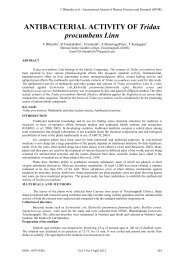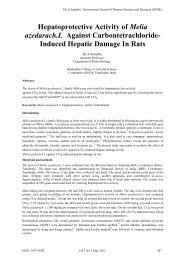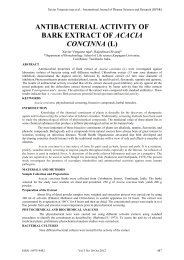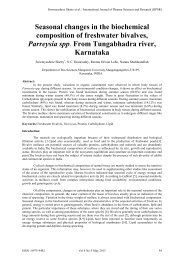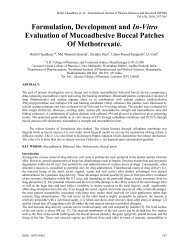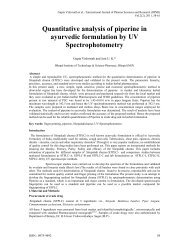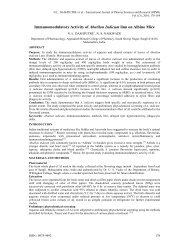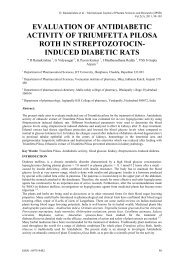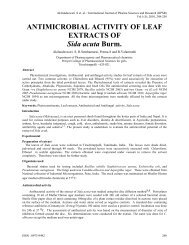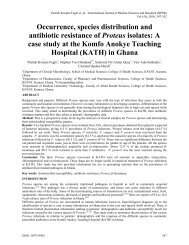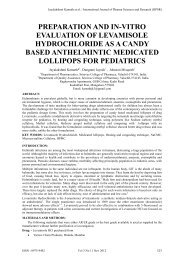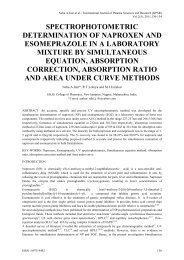synthesis of biologically active 2-chloro-n-alkyl/aryl acetamide ...
synthesis of biologically active 2-chloro-n-alkyl/aryl acetamide ...
synthesis of biologically active 2-chloro-n-alkyl/aryl acetamide ...
You also want an ePaper? Increase the reach of your titles
YUMPU automatically turns print PDFs into web optimized ePapers that Google loves.
S.A. Katke et al. / International Journal <strong>of</strong> Pharma Sciences and Research (IJPSR)<br />
Vol.2(7), 2011,148-156<br />
SYNTHESIS OF BIOLOGICALLY<br />
ACTIVE 2-CHLORO-N-ALKYL/ARYL<br />
ACETAMIDE DERIVATIVES<br />
S.A.Katke* ,S.V.Amrutkar , R.J.Bhor, M.V.Khairnar<br />
Department <strong>of</strong> Pharmaceutical Chemistry, MGV’s Pharmacy College, Panchavati, Nashik - 03 (Pune<br />
university), Maharashtra, India<br />
*Corresponding author: katke.shweta@yahoo.co.in, M: +919665487916<br />
ABSTRACT<br />
Medicinal chemistry plays an important role in development <strong>of</strong> drug for cure; maintain and improved health <strong>of</strong><br />
human being. It is also equally important to design chemical entities for prevent the growth <strong>of</strong> micro-organism,<br />
which come in contact with human being in day-to-day life. We have synthesized 2-<strong>chloro</strong>-N-<strong>alkyl</strong>/<strong>aryl</strong><br />
Acetamide derivatives with an aim as new bio<strong>active</strong> agent, which can be used as anti microbial agents such as<br />
herbicides, antifungal, disinfectant. The present study involves the <strong>synthesis</strong>, purification and characterization <strong>of</strong><br />
various N-substituted <strong>chloro</strong><strong>acetamide</strong> derivatives. The <strong>chloro</strong>acetyl chloride treated with various aliphatic and<br />
aromatic amines at room temperature with stirring for few hours with monitoring reaction by thin layer<br />
chromatography gave 2-<strong>chloro</strong>-N-<strong>alkyl</strong>/<strong>aryl</strong> Acetamide as solid compounds. We checked the melting point <strong>of</strong><br />
synthesized compounds with an open ended capillary tube method. The spectral techniques like Infra red and<br />
GC-MS have been used for characterization and establishment <strong>of</strong> structure <strong>of</strong> synthesized compounds. The<br />
antimicrobial screening <strong>of</strong> the synthesized <strong>chloro</strong><strong>acetamide</strong>s have shown excellent antibacterial and antifungal<br />
activity.<br />
Key words: Acetamide, antibacterial, antifungal.<br />
1. INTRODUCTION:<br />
Halogenated acids and acid derivatives compounds that eliminate or inhibit the development <strong>of</strong> bacteria,<br />
fungi, parasites or viruses are called antimicrobials and respectively r e f e r r e d to as antibacterial,<br />
antifungal, antiprotozoal and antiviral agents [2]. Numerous antimicrobial agents’ activity they can be toxic<br />
to human beings. Antimicrobials have to be non-toxic, non-allergenic, effective and selective,<br />
chemically stable, <strong>active</strong> against possibly more than one bacterium and inexpensive [3].<br />
Antibacterial agents usually act by modifying the structure or the metabolic pathways <strong>of</strong> bacteria.<br />
Disinfectants kill bacteria but are unselective and can be toxic for mammals and are not used in vivo. [4]<br />
Aryl<strong>acetamide</strong>s acts as anti microbial agents such as herbicides, antifungal, disinfectant .Examples <strong>of</strong> 2-<br />
<strong>chloro</strong> <strong>acetamide</strong>s which acts as herbicides such as 2-<strong>chloro</strong>-N-(2, 6-diethylphenyl)-N-(methoxymethyl)<br />
<strong>acetamide</strong> (a) and 2-<strong>chloro</strong>-N-(2, 6-dimethylphenyl)-N-[(3-methoxy-2-thienyl) methyl] <strong>acetamide</strong> (b) (Figure<br />
1) are shown. [7, 8]<br />
Four equivalents <strong>of</strong> <strong>chloro</strong>acetyl chloride was added drop wise over one hour to the aqueous amine<br />
solution. Then the solution was left to stir overnight. The desired reaction mixture was added to ice-cold water.<br />
Precipitate was filtered and recrystalised with ethanol[1,5]. 2-<strong>chloro</strong>-N- Alkyl or Aryl <strong>acetamide</strong> act as an<br />
intermediate which was synthesized by nucleophilic substitution reaction <strong>of</strong> <strong>chloro</strong>acetylchloride and different<br />
aqueous amines.(Figure 2)<br />
ISSN : 0975-9492 148
S.A. Katke et al. / International Journal <strong>of</strong> Pharma Sciences and Research (IJPSR)<br />
Vol.2(7), 2011,148-156<br />
O<br />
O<br />
Cl<br />
N<br />
O<br />
N<br />
S<br />
2-<strong>chloro</strong>-N-(2,6-diethylphenyl)-N-(methoxymethyl)<strong>acetamide</strong><br />
(a)<br />
O<br />
Cl<br />
2-<strong>chloro</strong>-N-(2,6-dimethylphenyl)-N-[(3-methoxy-2-thienyl)methyl]<strong>acetamide</strong><br />
(b)<br />
Figure 1: Examples <strong>of</strong> 2-<strong>chloro</strong><strong>acetamide</strong>s acting as herbicides.<br />
2. METHODS<br />
2.1. Chemistry<br />
All chemicals used were <strong>of</strong> Laboratory Reagent (LR) Grade. The synthesized derivatives were characterized by<br />
melting point, TLC, FT-IR, GC-MS and NMR. Thin Layer Chromatography was performed using Silica Gel G<br />
(Merck Index) coated on glass plates and the spots were visualized by exposure to iodine. Melting points were<br />
taken in open glass capillary tubes in liquid paraffin bath and were uncorrected. IR spectra were recorded on<br />
FTIR-8400S SHIMADZU spectrophotometer. GC-MS spectra & chromatogram were recorded on GCMS-QP<br />
2010 SHIMADZU instrument.<br />
2.1.1. Synthesis <strong>of</strong> 2-<strong>chloro</strong>-N-<strong>alkyl</strong>/<strong>aryl</strong> <strong>acetamide</strong> (3)<br />
Four equivalents <strong>of</strong> <strong>chloro</strong>acetyl chloride (1) was added drop wise over one hour to the aqueous amine (2)<br />
solution. Then the solution was left to stir overnight. The desired product was isolated as precipitate after<br />
pouring reaction mixture to an ice-cold water. Precipitate was filtered, washed with cold water and dried.<br />
Recrystalised using 95% ethanol (Figure 1).<br />
2.1.2. Chloro<strong>acetamide</strong> (3a)<br />
In 100 ml RBF, a solution <strong>of</strong> aqueous amine(0.02 mol) that is ammonia in 4ml water was stirred on magnetic<br />
stirrer for 10 min. Four equivalent <strong>of</strong> Ethyl <strong>chloro</strong>acetate(0.02 mol) was added drop wise for 1 hr. Reaction<br />
mixture was kept for stirring for 24 writhe reaction mixture was cooled, poured into ice-cold water (50 ml)<br />
containing a drop <strong>of</strong> pyridine and stirred until the oil solidifies. Crude product was filtered, washed with cold<br />
water and dried. The product was recrystallised from ethanol.<br />
Yield 83.21%, mp 118-120 0 C, and IR 3381.33cm -1 (NH-stretch) , 1627.97 (C=O stretch:1° amide), 1415.80<br />
(NH-bend:1° amide), 1286.56 (C-N stretch), 775.41 (C-Cl stretch) ,Mass spectrum [M + ], m/z 93 (100%) [M+1]<br />
93,[M+2] 78,[M+3]44.<br />
2.1.3. Phenyl Chloro<strong>acetamide</strong> (3b)<br />
It was obtained from (1) with aniline in crystalline form. Yield 82.77%, mp 140-142 0 C, and IR 3277.17cm -<br />
1 (NH-stretch: 2° amide) , 1688.48 (C=O stretch:2° amide), 1533.46 (NH-bend:2° amide), 1273.06 (C-N stretch),<br />
744.55 (C-Cl stretch) ,Mass spectrum [M + ], m/z 169 (100%) ,[M+1] 169, [M+2] 120, [M+3] 93.<br />
2.1.4. 2-<strong>chloro</strong>-N-m-toly<strong>acetamide</strong> (3c)<br />
It was obtained from (1) with m-toludine in crystalline form. Yield 21.55%, mp 86-91 0 C, and IR 3294.53cm -<br />
1 (NH-stretch: 2° amide) , 1672.34 (C=O stretch:2° amide), 1550.82 (NH-bend:2° amide), 1417.73 (C-N stretch),<br />
895.00 (C-Cl stretch) ,Mass spectrum [M + ], m/z 183(100%) [M+1] 183, [M+2] 120, [M+3] 107.<br />
2.1.5. 2-<strong>chloro</strong>-N-(3-<strong>chloro</strong>phenyl)<strong>acetamide</strong> (3d)<br />
It was obtained from (1) with aqueous m-<strong>chloro</strong> aniline in crystalline form. Yield 70.32%, mp 98-100 0 C, and IR<br />
3282.95cm -1 (NH-stretch: 2° amide) , 1666.55 (C=O stretch:2° amide), 1600.97 (NH-bend:2° amide), 1442.80<br />
(C-N stretch), 1091.75 (C-Cl stretch) , 898.96(Meta-disubstituted benzene ring),Mass spectrum [M + ], m/z<br />
203(100%), [M + ] 207, [M+1] 203, [M+2] 154, [M+4] 127.<br />
2.1.6. 2-<strong>chloro</strong>-N-(2-<strong>chloro</strong>phenyl)<strong>acetamide</strong> (3e)<br />
ISSN : 0975-9492 149
S.A. Katke et al. / International Journal <strong>of</strong> Pharma Sciences and Research (IJPSR)<br />
Vol.2(7), 2011,148-156<br />
It was obtained from (1) with aqueous o-<strong>chloro</strong> aniline in crystalline form. Yield 82.14%, mp 65-67 0 C, and IR<br />
3259.81cm -1 (NH-stretch: 2° amide) , 1658.84 (C=O stretch:2° amide), 1543.10 (NH-bend:2° amide), 1435.09<br />
(C-N stretch), 1045.45 (C-Cl stretch) , 690.54 (Ortho-disubstituted benzene ring),Mass spectrum [M + ], m/z<br />
203(100%), [M + ] 207, [M+1]203, [M+2] 168.<br />
2.1.7. 2-<strong>chloro</strong>-N-(2-methoxyphenyl)<strong>acetamide</strong> (3f)<br />
It was obtained from (1) with aqueous o-methoxy aniline in crystalline form. Yield 59.62%, mp 40-42 0 C, and IR<br />
3271.38cm -1 (NH-stretch: 2° amide) , 1668.48 (C=O stretch:2° amide), 1543.10 (NH-bend:2° amide), 1475.59<br />
(C-N stretch), 785-540 (C-Cl stretch) , 759.98 (Ortho-disubstituted benzene ring),Mass spectrum [M + ], m/z<br />
199(100%), [M+1]199, [M+2] 150 [M+3] 122.<br />
2.1.8. 2-<strong>chloro</strong>-N-(4-methoxyphenyl)<strong>acetamide</strong> (3g)<br />
It was obtained from (1) with aqueous p-methoxy aniline in crystalline form. Yield 38.17%, mp 118-120 0 C, and<br />
IR 3286.81cm -1 (NH-stretch: 2° amide) , 1658.84 (C=O stretch:2° amide), 1531.53 (NH-bend:2° amide),<br />
1438.94 (C-N stretch), 785-540 (C-Cl stretch) , 810.13 (Para-disubstituted benzene ring), Mass spectrum [M + ],<br />
m/z 199(100%), [M+1] 199, [M+2] 122, [M+3] 108.<br />
2.1.9. 2-<strong>chloro</strong>-N-methyl-N-phenyl<strong>acetamide</strong> (3h)<br />
It was obtained from (1) with N-methyl aniline in crystalline form. Yield 25.80%, mp 66-68 0 C, and IR 1670.41<br />
(C=O stretch:3° amide), 3049.56 (C-N stretch: 3° amide), 785-540 (C-Cl stretch) , 563.23 (Monosubstituted<br />
benzene ring), Mass spectrum [M + ], m/z 183(100%), [M+1] 183, [M+2] 148, [M+3] 106.<br />
2.1.10. N-benzyl-2-<strong>chloro</strong><strong>acetamide</strong> (3i)<br />
It was obtained from (1) with benzylamine in crystalline form. Yield 40.77%, mp 91-93 0 C, and IR 3275.24cm -<br />
1 (NH-stretch: 2° amide) , 1624.12 (C=O stretch:2° amide), 1543.10 (NH-bend:2° amide), 1438.94 (C-N stretch),<br />
785-540 (C-Cl stretch) , 567.03 (Monosubstituted benzene ring), Mass spectrum [M + ], m/z 183(100%), [M+1]<br />
183, [M+2] 148.<br />
2.1.11. 2-<strong>chloro</strong>-N-(4-nitrophenyl)<strong>acetamide</strong> (3j)<br />
It was obtained from (1) with aqueous p-nitro aniline in crystalline form. Yield 23.90%, mp 180-183 0 C, and IR<br />
3279.10cm -1 (NH-stretch: 2° amide) , 1670.41 (C=O stretch:2° amide), 1591.33 (NH-bend:2° amide), 1502.60<br />
(C-N stretch), (C-Cl stretch) , 850.64 (Para-disubstituted benzene ring), 850.64 (NO 2 -Asymmetric stretch), Mass<br />
spectrum [M + ], m/z 214(100%), [M + ] 216, [M+1] 214, [M+2] 166, [M+3] 138.<br />
2.1.12. 2-<strong>chloro</strong>-N-(4-flurophenyl)<strong>acetamide</strong> (3k)<br />
It was obtained from (1) with aqueous p-fluro aniline in crystalline form. Yield %, mp 0 C, and IR 3271.38 cm -<br />
1 (NH-stretch: 2° amide) , 1651.12 (C=O stretch:2° amide), 1535.39 (NH-bend:2° amide), 1502.60 (C-N stretch),<br />
(C-Cl stretch) , 825.56 (Para-disubstituted benzene ring), 1219.05 (C-F stretch), Mass spectrum [M + ], m/z<br />
199(100%).<br />
2.1.13. 2-<strong>chloro</strong>-N-(naphthalen-2-yl)<strong>acetamide</strong> (3l)<br />
It was obtained from (1) with 2-naphthalene in crystalline form. Yield %, mp 0 C, and IR 3252.09cm -1 (NHstretch:<br />
2° amide) , 1660.77 (C=O stretch:2° amide), 1562.75 (NH-bend:2° amide), 1404.22 (C-N stretch),<br />
752.26 (1,2 disubstituted benzene ring) , 856.42 (Meta-disubstituted benzene ring), Mass spectrum [M + ], m/z<br />
147(100%) [M + ] 219, [M+1] 184, [M+2] 170, [M+3] 143.<br />
ISSN : 0975-9492 150
Figure 2: Synthesis <strong>of</strong> 2-<strong>chloro</strong>-N-<strong>alkyl</strong>/<strong>aryl</strong> <strong>acetamide</strong><br />
2.2. Biological activity<br />
S.A. Katke et al. / International Journal <strong>of</strong> Pharma Sciences and Research (IJPSR)<br />
Vol.2(7), 2011,148-156<br />
Thirteen compounds were screened in vitro for their antimicrobial activity .Samples were prepare in a 1 mg<br />
mL -1 solution <strong>of</strong> DMF (Dimethyl formamide) and send to BAC –test laboratory,Nashik,India. They made test<br />
against four strains <strong>of</strong> bacteria E-coli (ATCC 25922), Pseudomonas aeruginosa (ATCC 27853), Staphylococcus<br />
aureus (ATCC 25923), which shown antibacterial activity and another microorganism that is Candida sp. for<br />
antifungal activity by agar diffusion technique. The bacteria were maintained on nutrient agar ,DMF showed no<br />
inhibition zone. The agar media was inoculated with different microorganisms culture tested. After 24 hr <strong>of</strong><br />
incubation at 30 0 c, the diameter <strong>of</strong> inhibition zone (mm) was measured and Gentamicin for antibacterial<br />
activity, Amphotericin B for antifungal activity was used as references(Figure 3-5).. Acetamide derivatives have<br />
shown excellent antibacterial and antifungal activity(Figure 6,7).<br />
3. RESULT<br />
Figure 3: Activity <strong>of</strong> E-coli strain (ATCC 25922)<br />
Figure 4: Activity <strong>of</strong> Pseudomonas aeruginosa (ATCC 27853)<br />
ISSN : 0975-9492 151
S.A. Katke et al. / International Journal <strong>of</strong> Pharma Sciences and Research (IJPSR)<br />
Vol.2(7), 2011,148-156<br />
Figure 5: Activity <strong>of</strong> Staphylococcus aureus (ATCC 25923)<br />
3.1. SYNTHETIC RESULT<br />
The structures <strong>of</strong> the synthesized compounds were confirmed by IR, GC-MS and 1 H NMR. Structures, yields,<br />
melting points and R F values <strong>of</strong> the synthesized compounds are reported. (Table 3.1.1)<br />
Table 3.1.1: Physical characterization <strong>of</strong> 2-<strong>chloro</strong>-N- Alkyl/Aryl <strong>acetamide</strong> derivatives<br />
No. R Code Melting point<br />
( 0 C)<br />
1<br />
2<br />
Yield<br />
(%)<br />
R f value<br />
3a 118-120 83.21% 0.65<br />
3b 140-142 82.77% 0.62<br />
3<br />
3c 86-91 21.55% 0.63<br />
4<br />
3d 98-99 70.32% 0.66<br />
ISSN : 0975-9492 152
S.A. Katke et al. / International Journal <strong>of</strong> Pharma Sciences and Research (IJPSR)<br />
Vol.2(7), 2011,148-156<br />
5<br />
3e 65-67 82.14% 0.59<br />
6<br />
3f 40-42 59.62% 0.56<br />
7<br />
3g 118-120 38.17%<br />
0.71<br />
8<br />
3h 66-68 25.80% 0.57<br />
9<br />
3i 91-93 40.77% 0.72<br />
10<br />
3j 180-183 23.90% 0.68<br />
11<br />
F<br />
3k 127-130 53.07% 0.52<br />
12<br />
3l 155-158 61.02% 0.40<br />
ISSN : 0975-9492 153
S.A. Katke et al. / International Journal <strong>of</strong> Pharma Sciences and Research (IJPSR)<br />
Code Code<br />
E.coli Pseudomonas aeruginosa<br />
Sample<br />
Vol.2(7),<br />
Staphylococcus<br />
2011,148-156<br />
aureus<br />
No. No.<br />
ATCC 25922<br />
ATCC 27853<br />
ATCC 25923<br />
3a 1. CA 7 mm 16 mm No zone<br />
3b 2. PCA 26 mm 23 mm 25 mm<br />
3c 3. CMTA 30 mm 35 mm 36 mm<br />
3d 4. C-3-CPA 27 mm 29 mm 30 mm<br />
3e 5. C-2-CPA 30 mm 30 mm 36 mm<br />
3f 6. C-2-MPA 7 mm No zone 10 mm<br />
3g 7. C-4-MPA 26 mm 25 mm 25 mm<br />
3h 8. CMPA 28 mm 28 mm 27 mm<br />
3i 9. BCA No zone No zone No zone<br />
3j 10. CNPA 28 mm 28 mm 35 mm<br />
3k 11. CFPA 28 mm 30 mm 35 mm<br />
3l 12. CNA 27 mm 29 mm 30 mm<br />
3m 13. APC No zone No zone No zone<br />
14. Gentamicin 14 mm 20 mm 20 mm<br />
3.2 PHARMACOLOGICAL RESULT<br />
Antimicrobiological activity was performed against gram positive, gram negative bacteria and fungi.<br />
Table 3.2.1: Antibacterial activity<br />
Figure 6: 2-<strong>chloro</strong>-N-<strong>alkyl</strong>/<strong>aryl</strong> Acetamide derivatives showing Antibacterial activity<br />
ISSN : 0975-9492 154
S.A. Katke et al. / International Journal <strong>of</strong> Pharma Sciences and Research (IJPSR)<br />
Vol.2(7), 2011,148-156<br />
Table 3.2.2: Antifungal activity<br />
Code No. Sample Candida sp.<br />
No.<br />
3a 1. CA No zone<br />
3b 2. PCA 14 mm<br />
3c 3. CMTA 11 mm<br />
3d 4. C-3-CPA 23 mm<br />
3e 5. C-2-CPA 21 mm<br />
3f 6. C-2-MPA 20 mm<br />
3g 7. C-4-MPA 12 mm<br />
3h 8. CMPA 29 mm<br />
3i 9. BCA No zone<br />
3j 10. CNPA 15 mm<br />
3k 11. CFPA 22 mm<br />
3l 12. CNA 15 mm<br />
3m 13. APC No zone<br />
14. Amphotericin B 20 mm<br />
Figure 7: 2-<strong>chloro</strong>-N-<strong>alkyl</strong>/<strong>aryl</strong> <strong>acetamide</strong> derivatives showing Antifungal activity<br />
4. DISCUSSION<br />
All compounds which are synthesized from <strong>chloro</strong>acetyl chloride and aqueous amine reaction which was stirred<br />
overnight are <strong>biologically</strong> <strong>active</strong>. And they have shown good antimicrobial activity against gram positive and<br />
gram negative bacteria and fungi. A result <strong>of</strong> activity proves that Chloro<strong>acetamide</strong>s can be used as Disinfectants,<br />
Surfactants, Preservatives, and Herbicides.<br />
5. ACKNOWLEDGEMENT<br />
The Authors are thankful to the management and Pr<strong>of</strong>. V.M. Aurangabadkar, Principal, M.G.V.’s Pharmacy<br />
College, Nasik for their support throughout the research project.<br />
6. REFERENCES<br />
[1] J.H Andrew, G.Thorfinnur :Synthesis <strong>of</strong> α-<strong>chloro</strong>amides in water. Tetrahedron Letters, 2006, 47: 6321–6324.<br />
[2] Micky JAA, N.M Saleh , S.M Mohamed, et.al. :Reaction and antimicrobial activity <strong>of</strong> 1-<strong>aryl</strong>ethylene benz<strong>of</strong>uranyl ketone derivatives.<br />
Indian Journal <strong>of</strong> chemistry, 2006, 45B: 1579-1583.<br />
[3] L.P Carrod, F.D Grady: Antibiotic and chemotherapy, Churchill Livingstone, Edinburgh, 3 rd edition 1972: 477.<br />
[4] R. El-Sayed, AAF Wasfy, A. A Aly: Synthesis <strong>of</strong> Novel heterocyclic with antimicrobial and surface activity.<br />
ISSN : 0975-9492 155
S.A. Katke et al. / International Journal <strong>of</strong> Pharma Sciences and Research (IJPSR)<br />
Vol.2(7), 2011,148-156<br />
[5] S. Waya :Synthesis <strong>of</strong> <strong>biologically</strong> <strong>active</strong> indole fused heterocyclic derivatives: Department <strong>of</strong> chemistry Wollongong, Australia, Feb<br />
2005: 49; 133-142.<br />
[6] V. Betina: The Chemistry and Biology <strong>of</strong> Antibiotics, Elsevier Scientific: Oxford, Amsterdam, 5 th volume 1983.<br />
[7] C.A Duckworth:Stable emulsion flowable formulation <strong>of</strong> a 2-<strong>chloro</strong><strong>acetamide</strong> herbicide and an imidazolinone herbicide; US patent:<br />
5,538,938; 199.<br />
[8] T Ikeuchi, T ohkawa, S ohno . Phytotoxicity controlling agent for upland farming and phytotoxicity controlling agent method using<br />
the same; EP patent:2008<br />
ISSN : 0975-9492 156



